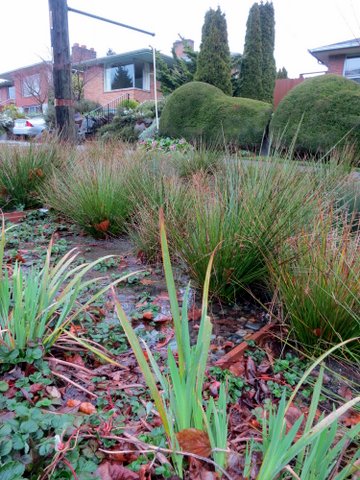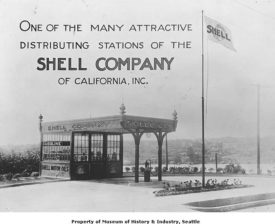The Pollution Control Hearings Board—the legal body presiding over state environmental regulations—has upheld the stormwater permits governing Western Washington cities and counties. The decision was issued this spring by the three-person board after permittees challenged the rules.
The state Department of Ecology in August last year approved the municipal stormwater permits, which aim to clean up and control polluted runoff that fouls Puget Sound and local lakes, rivers, and streams.
The permits require cities and counties to update their development regulations so they require the use of green technologies that catch and soak rain water where it falls, instead of sluicing it across asphalt and roofs and into gutters and drains that dump it into sensitive waterways. The green solutions include permeable pavement that rain percolates through to the ground and extra-absorbent, souped-up rain gardens called “bioretention facilities.”
The permits also tackle the torrents of dirty runoff with a big-picture effort to measure its damage. The regulations require King, Pierce, Snohomish, and Clark counties to consider stormwater effects in an entire watershed, which includes all of the land that drains into a specific body of water. The goal is to make sure we’re keeping an eye on the overall effects of development on water bodies.
While some folks criticize the rules for failing to sufficiently protect existing forests and green spaces from development, they’re still pretty ambitious in their attempt to make enviro-friendly stormwater solutions the norm—and not the exception.
But faster than a rain barrel fills in a downpour, cities and counties from around the region challenged the rules as:
“unlawful, unjust, unreasonable, impracticable, vague, ambiguous, economically infeasible and/or set forth mandates of unknown effectiveness in ameliorating, treating and/or controlling municipal stormwater;”
and also:
“beyond the authority of Ecology to impose, contrary to the Washington State constitution, contrary to the United States constitution…”
In October the board issued a slew of summary judgments, mostly supporting Ecology and the environmental groups that backed the department (see my earlier blog post on the case).
In the ruling released in March, the board continued to come down almost entirely on Ecology’s side.
Three main objections

Stormwater fail: a non-green gutter pours polluted stormwater into Puget Sound. Image by Lisa Stiffler (Used with permission)
Last summer Ecology issued two municipal stormwater permits: Phase I, which applies to Seattle, Tacoma, King, Pierce, Snohomish, and Clark counties, and Phase II, which regulates dozens of smaller counties and cities around Western Washington (the Phase II municipalities are listed here, as well as a list of “secondary permittees” such as ports and universities). The permits run from August 1, 2013 until July 31, 2018.
The case against the permits was brought by municipalities and private entities including King, Pierce, Snohomish, Clark, and Cowlitz counties; Auburn, Bainbridge Island, Bremerton, Burlington, Des Moines, Everett, Kent, Issaquah, Lynnwood, Mount Vernon, Renton, and SeaTac; and the Building Industry Association of Clark County.
Those supporting Ecology include Puget Soundkeeper Alliance, Washington Environmental Council, and the Rosemere Neighborhood Association.
In its ruling, the board broke the plaintiffs’ concerns into three main categories:
- Objections to the requirements that municipalities mandate the use of green stormwater solutions, also called low-impact development or LID. They basically said the technology cost too much and was not proven to work.
- Objections to the requirement that the four counties do large-scale, watershed analysis and planning. The challengers said the requirements were unlawful, unjust, unreasonable, or impracticable.
- Lacking an opportunity for “meaningful review” of the new rules.
LID deemed workable
On the first point, the board already has ruled that green stormwater solutions are workable. When municipalities challenged Ecology’s 2007 stormwater permit—which preceded the 2013 permit—the board concluded that LID provides “a known available method to address stormwater runoff” and that the strategies “are technologically and economically feasible and capable of application at the site, parcel, and subdivision level.”
In fact, the board told Ecology “to require greater application of LID at the parcel and subdivision level, where feasible.”
In the most recent ruling, the board again upheld the LID requirements. It ruled that while the permits tell folks to use green solutions as much as possible, the regulations also give them plenty of options for scuttling LID in situations where it won’t work.
Or as the board explained:
“…the permits provide significant flexibility to the permittees in the application of LID at the parcel and subdivision level, offering a complex array of alternative methods of compliance, exceptions, criteria for application of an infeasibility standard or consideration of other competing needs, among other items. While the Permits allow such flexibility, the overall approach of the Permits is to move the municipalities further toward compliance with water quality standards.”

Permeable pavers in West Seattle. Image by Lisa Stiffler (Used with permission)
Folks challenging the permit also raised concerns about requirements describing how the super-charged rain gardens are built. In particular, they questioned instructions on the soil used in the bioretention facilities. More than a year ago, researchers found that new rain gardens built in Redmond following current guidelines were releasing significant amounts of pollution. That has scientists hustling to figure out the best soil mix to use in the bioretention facilities to soak up water, remove pollutants, and grow plants.
In response, the board said not to worry. Phase I municipalities have until July 1, 2015 to update their stormwater codes and Phase II jurisdictions have until the end of 2016.
“Ecology has sufficient time to gather more sampling data and, if necessary, refine the prescribed soil mix before its usage is required under the Permits,” wrote the board.
The board did order Ecology to make a change regarding the use of permeable pavement. Porous concrete and permeable asphalt have primarily been used in areas with less or slower moving traffic such as parking lots, driveways, and sidewalks. Given that there is more limited experience using these materials on busy roads and freeways, the board instructed Ecology to restrict the use of permeable pavement to “very low-volume roads and very low truck-traffic areas.”
Watershed moment
Regarding the watershed component, the permit requires King, Pierce, Snohomish, and Clark counties to conduct watershed-scale stormwater planning.
To do this, they must estimate how the water flow in a select watershed has changed from its historic conditions, and predict what will happen with water quality and plants and animals when an area is fully developed according to land-use plans. The municipalities use computer modeling and in-the-field testing to accomplish this analysis.
One of the sticking points for this provision is that the watersheds can often include land owned by cities, counties, or tribes outside of the four counties covered by the rules. To get a complete picture of what’s happening, these counties need the help of the other landowners, but the permit doesn’t require them to participate. It’s a legitimate hurdle.
But instead of scrapping the watershed rules, the board took a bold turn in the other direction, ordering Ecology to:
“obligate permittees to participate in the watershed-scale stormwater planning process, provide the data necessary for that planning process, and develop and evaluate stormwater management strategies to meet water quality standards in the portion of the watershed that is within their respective jurisdictions.”
A green-leaning board
 On the third matter of whether municipalities had enough time to review the rules, the board said they had, noting that many of the governments even helped develop the permits.
On the third matter of whether municipalities had enough time to review the rules, the board said they had, noting that many of the governments even helped develop the permits.
So with some relatively minor revisions here and there, the board gave an unambiguous thumbs up to the new stormwater regulations.
In fact, after spending a few hours with the 92-page ruling, I was left wondering who in the heck the permit-embracing board members are. To close this post, let’s take a quick look.
The Pollution Control Hearings Board has three members who are appointed by the governor and confirmed by the state Senate. They serve for six years and hear appeals to environmental rules and orders issued by Ecology and other state agencies. The board is not affiliated with the agencies that enact the rules.
Current members:
Joan Marchioro: Marchioro was an administrative appeals judge with the Environmental and Land Use Hearings Office, which the board is a part of, before Democratic Gov. Jay Inslee appointed her to the board in June 2013. Before then, she served in the Washington State Attorney General’s Office for 22 years where she represented Ecology and the Department of Revenue.
Tom McDonald: McDonald is a former environmental attorney who was appointed by former Gov. Chris Gregoire, a Democrat. He took the position in December 2011 to fill a seat vacated by a resigning member and his term ends this summer. He previously worked in Olympia for Cascadia Law Group and Perkins Coie. Before that he also worked for Washington’s Attorney General, as well as the Attorney General for Colorado.
Kathleen Mix: Mix was appointed in December 2005, also by Gregoire. She was reappointed to her post in 2011, and her term ends in two years. She worked from 1993 to January 2005 as Chief Deputy Attorney General for Gregoire when she was serving in the role of the state’s Attorney General.









Brian Wegener
Lisa,
Have you done a comparison between the Western Washington MS4 permits and the MS4 permits in the Phase I communities in Oregon? I am wondering if the Oregon cities are preventing pollution to the maximum extent practicable.
Lisa Stiffler
Brilliant idea! I will take a look at how the states stack up. Thanks for the suggestion.
Phil Jones
Lisa, thanks for reporting on this! And a heartfelt “thank you!” to the board, for acting in the long-term best interest of the community. Our society seems to always value short-term expediency over long-term value; these decisions fall on the correct side of the ledger.
Phil
Lisa Stiffler
Thanks for the feedback. It seems like the rules are a decent start, but as many folks have said to me, it really depends on the cities and counties to embrace the use of green infrastructure. There remain plenty of “off ramps” that allow municipalities to duck their use if they’re not on board with the technology. We’ll have to all stay tuned.
Peg Staeheli
Lisa and Sightline –
We all thank you for keeping us informed and providing a format for discussion. Sightline played a major role in defining the issues and providing the detailed background.
Lisa Stiffler
Thanks, Peg! Please post requests or email me if there’s an angle to any of this that the stormwater community needs someone to dig into in more depth. I’m always open to suggestions.